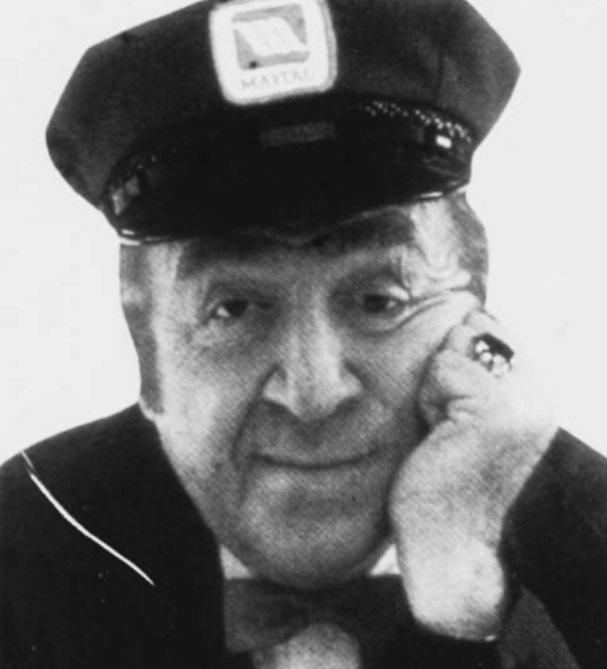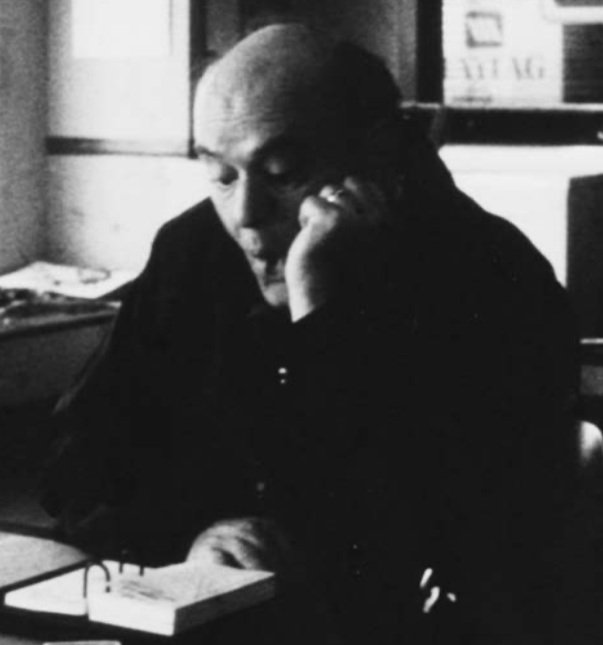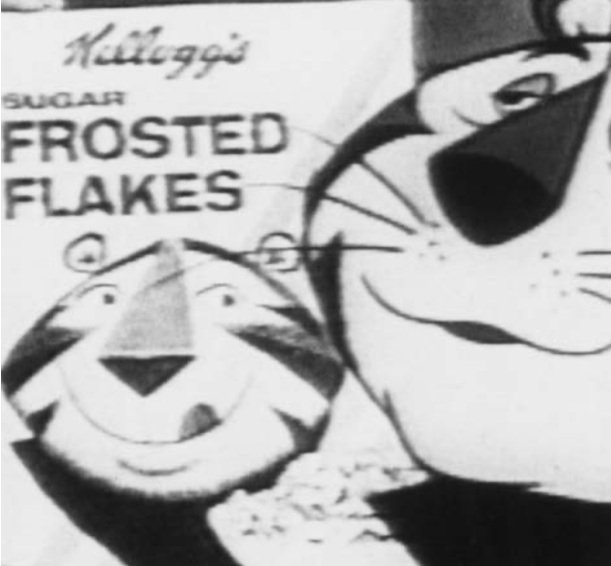Advertising
Advertising
Kellogg’s Tony the Tiger.
Tony the TigerTM is a trademark of the Kellogg Company. All rights reserved. Used with permission.
In late November 2001, the FOX network announced that it had already sold 70 percent of the 58 commercial slots for the upcoming Super Bowl on February 3, 2002. The going rate was estimated at $2 million for 30 seconds. FOX expected to generate over $200 million, about the same as CBS had earned the previous year, despite a general decline in advertising, occasioned by a recession and the terrorist assault on the United States on September 11, 2001. Regular advertisers such as Anheuser-Busch (with ten spots), PepsiCo, Levi Strauss, and Pizza Hut accounted for most of the sales. The investment was justified because executives expected the Super Bowl to fulfill its objective: to attract the largest television audience of the year. This example is merely one indication of advertising’s continuing and central role in the story of television.



Maytag’s Lonely Repairman.
© Maytag Company/Courtesy of Leo Burnett USA, Inc.
Maytag’s Lonely Repairman.
© Maytag Company/Courtesy of Leo Burnett USA, Inc.
Kellogg’s Tony the Tiger.
Tony the TigerTM is a trademark of the Kellogg Company. All rights reserved. Used with permission.
Bio
In the beginning of television history, the advertising numbers were hardly so extraordinary. In 1941, for example, Bulova Watches spent $9 to buy time on the first advertising spot offered by NBC’s fledgling New York station. Soon, however, success stories such as the case of Hazel Bishop cosmetics, whose jump into TV produced a sales explosion, convinced advertisers that it was worthwhile to pay much more to reach the expanding TV audience. Ad revenue fueled the televi- sion boom in the United States during the 1950s, and by 1960 TV had become the chief medium of national advertising, earning $1.5 billion as a result. Rating agencies, notably A.C. Nielsen Company, played a crucial role by measuring the audience size and estimating the audience composition of particular shows. Advertising shaped both programming and the schedule to maximize hits—at that time, largely sports and entertainment offerings. Indeed, ad agencies controlled the actual production of many shows, securing writers, technical personnel, and talent and overseeing scripts and production design. It was not until the quiz show scandals at the end of the 1950s led the networks to take control of their programming that the advertising agencies focused their work primarily on brokering airtime and producing commercial spots.
The success of commercial television as a medium linked to the selling of products provoked an outcry. Vance Packard’s 1957 exposé, The Hidden Persuaders, identified television as one of the chief villains in the effort to manipulate the American consumer. In 1961 the new chair of the Federal Communications Commission (FCC), Newton Minow, told a stunned audience of broadcast executives that television was “a vast wasteland,” funded by a seemingly endless supply of commercials.
Initially, few countries followed the U.S. example of supporting their new broadcast media with a commercial, advertiser-supported financial base. Britain, Canada, and much of Western Europe organized television as public service systems. Program development and production, as well as the technical aspects of broadcasting, were funded in part by taxes. However, the expenses of television broadcasting were so high and the private demand for commercial airtime so great that some services accommodated advertising: the Canadian Broadcasting Corporation (CBC), for example, used ad revenues to finance indigenous programming. Both Japan and Australia launched separate commercial and public services in 1953. A year later, ad agencies, now fully international in scope and influence (notably the U.S.-based J. Walter Thompson agency), played a part in convincing the British government to end the BBC monopoly and allow a new channel, a commercial service, to be placed on the air.
Even so, television commercials, the visible artifacts of advertising in their familiar 30- or 60-second versions (and, later, in a 15-second length), long retained the imprint of their American birth. Canadian advertisers hired U.S.-based talent in New York. Young and Rubicam, an American agency, created “Ice Mountain” for Gibbs toothpaste, the first British television commercial ever aired (September 1955). The prevalent strategy of American advertising in the 1950s was the 60-second “hard sell”: hit the viewer with bits of information, explain how the product is unique, repeat this argument to drive home the message. The earnest enthusiasm might please the advertisers, but it disturbed its targeted audience. If American viewers were largely satisfied with their television fare, according to a 1960 survey, they were upset by the frequency, the timing, the loudness, and the style of commercials. Still, few people in the United States were ready to pay for noncommercial television through their taxes or a license fee on the television receivers that sat in their living rooms.
Television advertising grew more sophisticated and extravagant during the 1960s. The advent of color TV accentuated the visual dimension of advertising. The increasing cost of airtime fostered a move toward 30- second commercials, which relied on metaphor even more than logic. Just as important was the “Creative Revolution” that swept over Madison Avenue, led by newcomers and new agencies experimenting with the “soft sell.” The emblem of this new movement was the funny and imaginative Volkswagen campaign that was widely credited with making the “Beetle” an American icon. Commercials were even more important to Marlboro cigarettes: sales doubled in the late 1960s, reaching 51.4 billion units, launching the brand on a trajectory that would make it the U.S. leader. One byproduct of the “revolution” was the appearance of spots that pleased viewers: the bouncy tune and happy images of Coca-Cola’s famous “Hilltop” spot (1971) may not have taught the world to sing, but it did lead enthusiastic viewers to phone television stations re- questing more showings of the ad.
After the mid-1960s, television advertising also be- came a significant tool of public power. The free public service announcement (PSA) won favor as a way of convincing people to donate moneys, to stop smoking or drinking and driving, or to fight drug abuse.
Political advertising was transformed by the “Daisy” spot, a miniature horror movie that used visuals to link Republican presidential candidate Barry Goldwater (who was running against President Lyndon B. Johnson, a Democrat) to the threat of nuclear holocaust. Shown only once (on CBS, September 7, 1964), the spot featured a young girl counting to ten while pulling the petals off a daisy. When she reaches “nine,” an adult voice begins counting down to zero, as the image of the girl dissolves to that of a nuclear explosion. The outcry this commercial provoked amply demonstrated how the political spot could affect viewers emotionally.
By 1988 half of the $92.1 million expended by the campaigns of Vice President George H.W. Bush (Re- publican) and his Democratic rival for the presidency, Massachusetts Governor Michael Dukakis, went to advertising, mostly on television. Even if these sums were much smaller than Coca-Cola or Procter and Gamble might spend in any given year, political advertising now challenged the news as the chief source of election discourse, evidenced by the attention paid to the “Willie Horton” attack ads that smeared Dukakis in 1988. By the 1994 midterm elections, not only had total ad spending in U.S. campaigns approached $1 billion but negative advertising had exploded in what a November 14 issue of Advertising Age called “the season of sleaze.” Meanwhile, the partial repeal of the Fairness Doctrine in 1987 had opened the airwaves to advocacy advertising. In 1993 the Health Insurance Association of America managed to catalyze public suspicion of the Clinton administration’s health initiative, with its “Harry and Louise” spots, which eventually contributed to the defeat of health reform. In the electoral con- test of 2000, the U.S. political parties and their allies practiced the equivalent of carpet bombing, running roughly 1 million spots in the country’s 75 major markets. Since so many people avoid political news, tele- vision advertising is now the single most important form of political discourse in the United States.
Americans have remained the masters of political and advocacy advertising. However, in other realms, U.S. supremacy has been challenged. American inventiveness declined in part because the “Creative Revolution” waned in the 1970s, with American advertisers coming to favor once more the hard sell. Furthermore, in country after country, private television triumphed over public television, thereby creating new channels for advertising. In the Third World, ad revenues were crucial to the expansion of television, although a fear of excessive commercialism justified Indonesia’s ban on television ads in 1981. First in Italy (in the mid-1970s), then in France (in the mid- 1980s), and soon everywhere, the airwaves of Western Europe were opened to private television. Following the collapse of the Soviet empire at the end of the 1980s, ads swiftly appeared in Eastern Europe and Russia: the Marlboro cowboy, banned from American screens after 1970, could be found riding proudly on Russian television in the summer of 1993. The spread of satellite TV in Europe after 1990 offered even more time for marketing.
The British were the first to break free from American tutelage. In the United Kingdom, ad makers refined the ironic sell, which became a key marketing strategy in Europe and North America during the late 1980s: one of the first major successes using the ironic approach was the long-lasting Heineken “Refreshes” campaign launched in 1974. Also in the 1970s, the British government sponsored social ads to shape public behavior, an initiative that was pursued in Canada as well, where the state often proved to be the largest single advertiser. British ad makers soon developed the shock style of social advertising, which used brutal images of misery, death, and horror to jolt people out of their complacency. This too became commonplace in the late 1980s and early 1990s, during the global war against AIDS, drugs, drinking and driving, racism, hunger, and other ills.
Worldwide, the best television commercials had be- come works of art that reflected the tastes, the fears, and the hopes of their communities. The sums of money spent on making commercials were enormous: it has been estimated that the ads for Pepsi-Cola’s “New Generation” campaign of the mid-1980s cost about $20,000 a second to produce, far more than reg- ular TV programming. European ad makers usually eschewed the American passion for the hard sell and comparative advertising. Many ads acquired a kind of national signature: bizarre imagery (France), a humorous emphasis (Britain), gentleness (Canada), sensuality (Brazil and France), exposé (Germany), or beauty (Japan). Some trends applied to the whole industry. During the course of the 1990s, for example, advertising throughout the affluent world became increasingly erotic, often mixing sex and humor, to sell food products, diets, cosmetics, clothing (especially jeans), alcohol, and soft drinks. The sexual sell even spread into other categories, notably car advertising. Perhaps it was not surprising that a 2001 survey of Canadians discovered many viewers thought there was too much sex in advertising.
All these developments suggest that there may be some truth to the claim by Marshall McLuhan (cited once again by Time magazine in 1990) that advertising was “the greatest art form of the twentieth century.” In fact, since 1980 television networks have offered up programs anthologizing old and new ads, movie houses have shown the world’s best commercials (the Cannes award winners), and newspapers and magazines have reviewed ads and advertising trends.
It would, of course, be an exaggeration to apply McLuhan’s label to every form of television advertising. Consider the infomercial, a form American ad makers pioneered during the late 1980s. Typically, the infomercial is a sponsored message, 30 minutes long, which masquerades as a regular program, often as a talk or interview show complete with commercial in- serts. The form has been used to hype hair restorers, diet plans, memory expanders, real estate techniques, living aids, gym equipment, and so on. One infomercial promoting Tae-Bo exercises, shown around 2,000 times a week, was credited in 1998 with rebuilding the market for fitness videos, its product even outselling Walt Disney’s movies. The earnest enthusiasm of the infomercial harks back to the ad style of the 1950s, while the element of direct response (the insistence that the viewer must phone now to purchase the brand) looks forward to the future of interactive television. The infomercial proved so successful by the mid- 1990s that it had spread into Britain and Western Europe. In the United States and Canada, major national marketers such as Ford or Philips were experimenting with this long-form advertising. It was estimated in the mid-1990s that infomercials were generating around $1 billion worth of ad business a year.
That figure nevertheless remained modest by comparison with the scale of conventional television advertising. Altogether, television attracted over $59 billion of the total $244 billion of U.S. advertising volume in 2000, which put the medium nearly on a par with print. Indeed, in Japan, France, Italy, Brazil, and Spain, TV beat out all other media. In the United States, however, the rise of both independent and cable television over the previous two decades had dramatically altered the shares of this revenue. The “Big Three” networks—ABC, CBS, and NBC—now secured just over $14 billion, compared to nearly $11 billion for U.S. cable networks. Local spot-advertising stood at $13.5 billion. The television ad market had fragmented as a result of the proliferation of channels available to the viewing audience. The result was that advertisers had difficulty reaching masses of viewers at any one time, unless they were willing to pay out huge sums to cover all the main channels. One exception, of course, was the Super Bowl, which is why the network broadcasting the game could charge so much for a 30-second ad.
In fact, for roughly a decade, the future significance, and thus the prosperity, of television advertising has been in question. The record of television advertising as a marketing tool is not always spectacular: people avoid, discount, or disdain most commercials they see. The enormous clutter of ads on television has made recent campaigns much less memorable than ten or 20 years ago, or so surveys suggest. Advertisers have long been concerned by stories about viewers who use their remote controls to mute commercial messages or skip through the channels during a commercial break. The recent arrival of personal digital video recorders offered by TiVo or Microsoft’s Ultimate TV have reawakened industry fears that viewers might construct their own ad-free television. Even so, no other rival has emerged to challenge the potential marketing power of TV. One of the ironies of the Internet craze of the late 1990s was that the “dot-coms” used television ads to deliver their messages to consumers: during the 1999 Super Bowl, for example, ABC charged some dot-coms as much as $3 million for a 30-second spot. So far, advertising on the Internet has not proved a threat to television ad revenues, amounting to less than 2 percent of the total advertising expenditures in 2000.
The laments of a Packard or a Minow have been echoed by an assortment of critics around the world who have blamed advertising for vulgarizing TV, degrading politics, and emphasizing materialism. Indeed, television advertising is often viewed as the most potent agent of a gospel of consumption. A central tenet of that gospel preaches that satisfaction is for sale. “What advertising has done is to seep out beyond its proper sphere,” asserted media scholar Mark Crispin Miller in an NBC documentary, Sex, Buys, and Advertising (July 31, 1990), “and to kind of take over the culture.”
Ultimately, such claims rest upon a presumption of the awesome cultural power of advertising. Advertising has conditioned the character of television programming, sometimes even inspired a program: Coca-Cola’s “Mean Joe Greene” commercial (1979) was the model for a later NBC movie. The music video began life as a method for advertising rock groups, only to later become a form of entertainment and the foundation for the success of the cable network MTV and its imitators. Ad slogans have entered the common language: for example, the fast-food chain Wendy’s query, “Where’s the beef?” found a place in the 1984 U.S. presidential campaign. Ad critters, notably Kellogg’s Tony the Tiger, have become kids’ favorites. Ad stars have become famous: the appearance of Nick Kamen in a Levi’s 501 ad in Britain in the mid-1980s made him a symbol of male sensuality. Since 2001 the notoriously sexy commercials for Victoria’s Secret have been effectively transformed into televised fashion shows.
Such examples demonstrate that commercials are another source of popular culture, a vast collection of meanings and pleasures created by the public to understand and enrich their ordinary experience. The appropriation, creation, and manipulation of these meanings and pleasures by those who assume that they help to sell products continues to be a source of intense cultural and social scrutiny and debate. All the while, the variety of effects of TV advertising on our lives remain contested.

